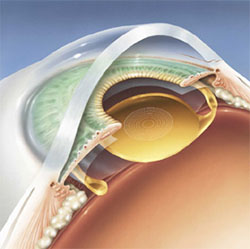CATARACTS
Cataracts are one of the most frequent causes of loss of vision, which fortunately can be recuperated. This is an ocular pathology which can affect people of all ages, but which is most prevalent in those over 65, although it can appear in younger people too.
Inside the eye, all human beings have a natural lens, called the crystalline lens, which we use to see well and read. With the passing of the years, and in some specific cases, this becomes opaque and changes color (in some cases it can acquire a pearl white color).
A cataract therefore is the opacity of the crystalline lens which progressively reduces vision and which can take years to appear. When this opacity increases, it produces a great deal of discomfort and diminishes the quality and clarity of our vision. Cataracts should be considered as a normal process in the life of every human being, but one which inconveniences some people more than others, depending on the activities or profession they are involved in. There are some symptoms which normally appear during the evolution of a cataract.


SYMPTOMS
The most common symptom is a decrease in vision, although initially the patient is unaware that a cataract is developing. Other symptoms , although less frequent , are blurred vision, occasionally double vision , bad night vision and paradoxically, the ability to read without glasses, when these were previously necessary. As the cataract increases, vision decreases and if it goes untreated it can result in blindness.
There exist other causes of cataracts : general diseases such as diabetes, rheumatic illnesses etc…and the consumption of medicaments, traumatic diseases, and congenital diseases.
When should cataracts be operated on ?
Although a cataract is not an ophthalmological emergency, it should be operated on when recommended by the ophthalmologist. This is contrary to the widespread opinion which was held in the past, that one should wait until the cataract completely closes off our vision. One should not wait until the ‘CATARACT MATURES’, as this increases risks during surgery. The treatment of a CATARACT is always surgical.
Current ophthalmological techniques allow us to operate on cataracts with sophisticated equipment and using local anesthetic. The principal surgical technique used by our team at the H.O.I. is phaco-emulsification, which eliminates the cataract by means of ultrasound. This is followed by the implantation of an intraocular lens with the diopters that the patient requires. See below for information about intraocular lenses. This lens is inserted into the eye through a small incision. With this technique, vision improves rapidly, with no need for the patient to be hospitalized, which means that at no point are they out of their normal environment and they can return home immediately after the procedure has taken place. There is also another group of cataracts, CONGENITAL CATARACTS. This type of cataract deserves a special mention because it affects very young children. Congenital cataracts must be operated on as soon as they are diagnosed, to avoid so-called lazy eyes or amblyopia. By doing so, the vision of the child is rehabilitated and they achieve useful vision. A patient who has been operated on for cataracts, once a month or two have gone by, will need to have their eyes tested for new prescription lenses as their eyesight will have improved considerably.
The intraocular lens which we implant after extracting the crystalline lens can be monofocal, bifocal, trifocal, Edof (Extended focus lens) and/or toric. With these lenses we can, if necessary, correct myopia, hyperopia, presbyopia or eye strain and astigmatism.


Las actuales técnicas oftalmológicas nos permiten operar las cataratas con equipos muy sofisticados y con anestesia local. La principal técnica quirúrgica utilizada por el equipo del I.O.H es la FACOEMULSIFICACIÓN, que elimina la catarata mediante ultrasonidos, para seguidamente implantar una lente intraocular con las dioptrías que el paciente requiere (Ver abajo tipos de lentes intraoculares). Esta lente es introducida en el ojo a través de una pequeña incisión. Con esta técnica, la visión mejora rápidamente, sin necesidad de hospitalizar al paciente, lo que significa que este no está en ningún momento fuera de su ambiente habitual y que puede regresar a su domicilio inmediatamente después de la intervención.
También existe otro grupo de catarata, LA CATARATA CONGÉNITA. Este tipo de catarata requiere una mención especial porque afectan a niños, a edades muy tempranas. Las cataratas congénitas deben ser operadas en cuanto se diagnostican, para evitar que se produzcan lo que se llaman "ojos gandules", ambliopes o perezosos. De este modo, se rehabilita la visión del niño y se logra una visión útil.
El paciente operado de CATARATAS, transcurridos uno o dos meses, precisará una nueva graduación de gafas porque su visión ha mejorado considerablemente.
La lente intraocular que implantamos después de extraer el cristalino, puede ser monofocal, bifocal, trifocal, Edof (Lente de foco extendido) y/o tórica. Con estas lentes podemos si es necesario corregir la miopía, la hipermetropía, la presbicia o vista cansada y el astigmatismo.
